Case Report - (2017) Volume 3, Issue 3
Marinella Dalmotto*
Department of Mental Health, Psycogeriatrics, Turin, ASL TO2, Italy
*Corresponding Author:
Marinella Dalmotto
Department of Mental Health
Psycogeriatrics, Turin
ASL TO2, Italy
Tel: 011725500
Fax: 011740092
E-mail: marinella.dalmotto@tiscali.it
Received Date: April 07, 2017; Accepted Date: April 18, 2017; Published Date: April 24, 2017
Citation: Dalmotto M. Can Dementia and Creativity Coexist? Acta Psychopathol. 2017, 3:3. doi: 10.4172/2469-6676.100088
Alzheimer ‘disease is still today a progressive disease, drugs have little effectiveness.
Aim: The aim of this report is to show that primary creativity keeps in Alzheimer’ disease and it is grown by art in therapeutic alternative way. Really, basic abilities are mediate by amigdala for long time during disease, so there is a therapeutic reactivity to art. As example experience of guided tours in pictures galleries, very frequent in foreign country, but still experimental in Italy. Moreover creativity experience of biography written by a person Alzheimer’ disease affected and some painters affected by the same disease. These experiences suggest as painting art recalling emotions and memories, improve sense of self.
Conclusion: Emotional and gestural acceptance, the remembrance of nice memories, the observation of beauty, takes to a pacifying memory in a creative way
Keywords
Alzheimer‘s disease; Amigdala; Cognitive; Dementia; Mental life
Introduction
Regarding creativity in old artists, like Renoir, we can see how creativity stays unscathed and, moreover helps the artists to fight their physical impairments.
In the ancient times Sophocles used to say: I am growing old and I keep learning.
What happens on the other hand if your cognitive capabilities?
Is it still possible to speak of creativity in dementia?
Dementia is so destabilizing that in his "Satire" Governable writes: "The worst of damages is dementia that makes the old forget the name of his servants, the face of his friend who ate with him the night before and not even that of his children who he gave birth to and who he grew up" [1].
First of all what is creativity?
Winnicot like Hillman distinguish between primary creativity essential for mental growth, development and conservation itself of a mental life, which exists even with impaired awareness and specific artistic creativity which is present both in young and old artists [2].
In daily life primary creativity tries to give meanings through senses and portrayal. It evokes reminiscences and fantasies of memories (in dementia patients the so-called confabulations) trying to find people to relate to.
Life in fact, as Gabriel Garcia Marquez says, is not the one you lived, but is what you remember of it and how you remember it to describe it.
Sometimes a sensation is sufficient to bring back to memory a long gone time. In the book "À la recherché du temps Perdue" by Marcel Proust, for example memories come to life because of the flavor of a madeleine at grandma's house, the sensations just like the reactions to human contact, are innate cerebral capacities that allow the expression of primary creativity as we will ascertain in Alzheimer’ s disease.
Methods
How primary creativity in Alzheimer‘s disease is stimulated by art
The artistic approach that initially consists in viewing some paintings or pictures of paintings chosen by therapists represents an alternative path to: 1) Regain the memory; 2) Evoke deep emotions that stimulate; 3) Emotional memory that is mediated by the amygdala (Figure 1) in the hippocampus which is the oldest part of the human brain and mostly untouched by dementia. Some answers in fact are innate and common like fetal reaction to music or, later on smiling to funny faces; 4) Subsequently proceeding in the artistic stimulation a communication between inner and outer world is created through the oral/written description of the painting restoring this way one's role of personal entity; 5) The artistic approach represents a tool for socialization sharing one's individuality within a group; it is a way to regain the dimension of taking action since the stimulated subject retrieves the perception of himself as person able to create.
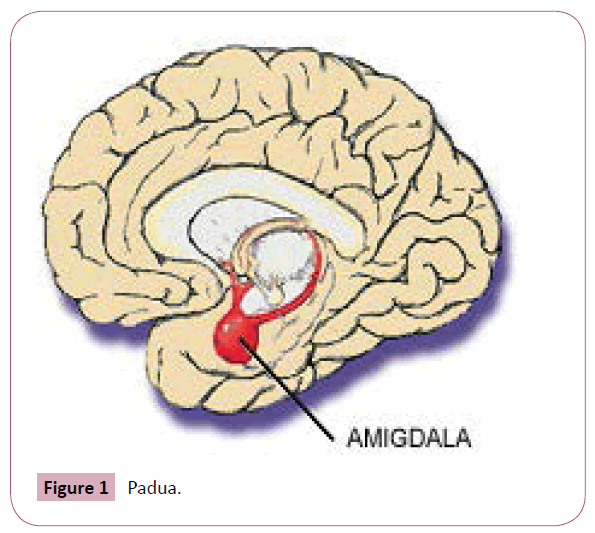
Figure 1: Padua.
Often non-seriously damaged dementia patients relate with the therapist, mostly non-verbally, the experience of desire as unconscious strives towards their neighbor; in other word they desire to be subjects of affection. It is therefore useful an emotional mothering where words are directed exactly to that patient, not to anyone else, and they satisfy the experience of the recognition and of the desire allowing the patient to go through pleasing and fulfilling experiences. It is from these basic abilities that comes the therapeutic reactivity to art [3].
Alzheimer’s disease primary creativity dimension stimulated by guided tours in picture galleries
This activity is often carried out and structured abroad since 2006; the program artists for Alzheimer (ARTZ) organizes guided tours in museums all over the world during closing times not to frighten the patients.
The artworks, selected by specialized operators, are duplicated and shown to the patients before going to the art gallery. The operators explain the artworks during the visit then the patients are asked to reproduce a painting. In these programs, still in experimental phase in Italy (Fondazione Manuli in Milan with the contribution of San Paolo Bank, Naples) Non serious Alzheimer patients show they are able to creatively understand visual art:
They perceive and describe: 1) Telling a story connected to the painting; 2) Relating it to their lives; 3) Pinpointing the emotions.
These experiences have positive effects on the emotional ailments of the patients facilitating an emotional contact.
All this proves that the preverbal thought, the affective knowledge and the emotional dimension including desire are still there in Alzheimer patients.
A destabilized thought like that in dementia can still have possibility and reasons of understanding what happens around the patient if it receives emotional and sensorial stimuli from the outside.
The emotion of love, tenderness the appreciation of beauty seems to go beyond the state of mind.
Kant for example, in old age affected by Alzheimer‘s disease, before his death caresses and recognizes his pupil.
I will now describe live one of these special visits for special patients: Gallery of Piazza della Scala in Milan. It is a small group: three older patients continuously chat. One of them has bizarre eccentric expressions, another one is ironic. The third one is troubled, tries to back out, it is necessary to hold his hand; every one of them expresses his personal reaction feeling different but stimulating experiences like the different colors of the leaflet.
The youngest operator says how touching it was" rediscovering the artwork together with the patients experience" [4].
The primary dimension of Alzheimer’s disease in biography
Smith Henderson professor of History at University, at the beginning of his Alzheimer’ s disease decided to describe his experience of sick person in a diary helped when the affection proceeded further by his daughter who transcribed his recorded voice.
It clearly comes out how the Alzheimer affected patient keeps his affective sensibility and the need to express it creatively."....one of the worse things in Alzheimer’s disease is that you feel terribly alone. No one of those around you really understands what is going on. Very often we do not know ourselves what is going on and another thing that drives me crazy is that no one really wants to talk with us anymore. Maybe they are afraid but Alzheimer’ disease is not contagious. In the hospital they treat me like a clinic case, without my history, without my inner part" [5].
What then? "Where the intellect cannot reach their supplies love" used to say St Augustin from Padua (Figure 2) therefore non-oral communication is very important.
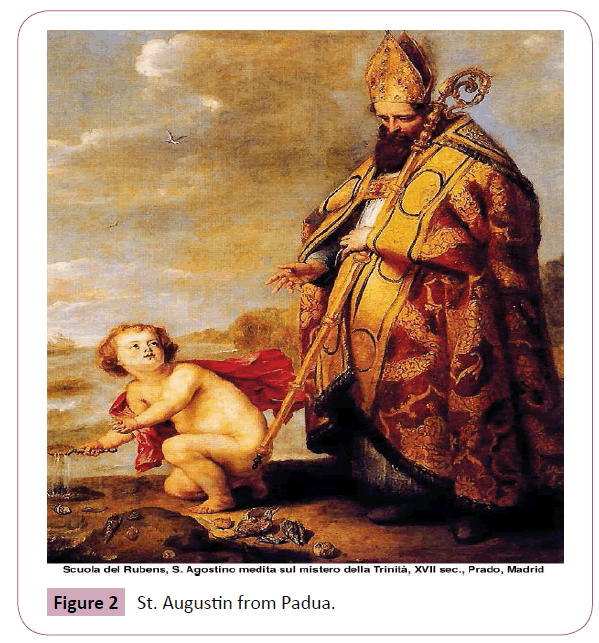
Figure 2: St. Augustin from Padua.
Even if the graphic involution in the Alzheimer patient is described as the return to the evolutionary phases described by Piaget any cognitive reorganization presumes a creative mental operation to acquire a new balance.
Dementia affected artists
The pictorial artistic production is a complex chore that involves sight, coordination, memory executive functions often deteriorated by dementia. Making it simple the left part of our brain presides over rational functions, the right one presides over creative ones. Subjects with artistic talents have in fact in the electroencephalogram a major representation of the parietal/occipital regions on the right compared to the left part of the brain. Subjects with orbital frontal lesions show a lower inhibition and can develop artistic capabilities not shown before; in this case we speak of paroxysmal functional facilitation as in frontal/temporal and semantic dementia. In 1988 Miller described in Neurology Journal the surfacing of artistic talent in 5 patients with frontal/temporal dementia; in these cases the sight functions are preserved and the patient overcomes the rules to freely express his emotions thanks to the facilitating function of the frontal connections (Figures 3 and 4).
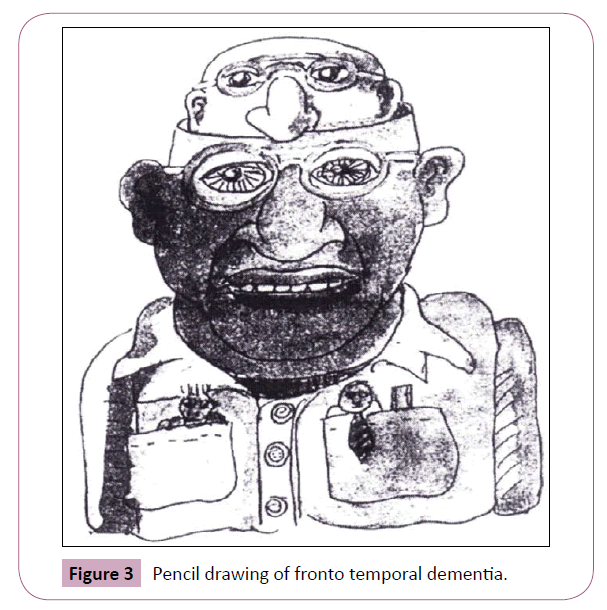
Figure 3: Pencil drawing of fronto temporal dementia.
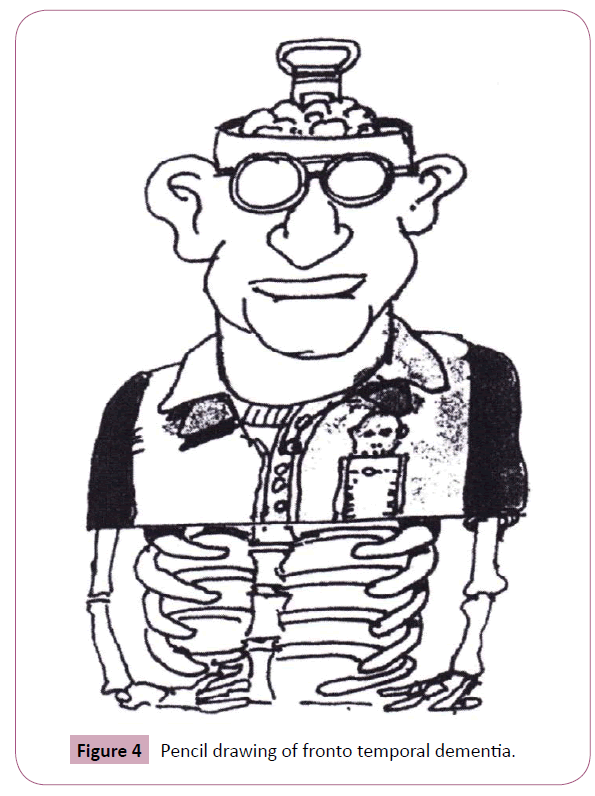
Figure 4: Pencil drawing of fronto temporal dementia.
Some artists kept on drawing after the start of Alzheimer‘s disease [6].
1) Carolus Horn refined German graphic designer and illustrator started suffering AD in 1980 but kept on working. Comparing the representation of Rialto Bridge before and after a few years of the disease we notice the alteration of the perception of depth and loss of three-dimensionality, besides the object and shapes are getting simpler. The touch of originality in the second painting is related to the painter’s higher freedom from academic schemes (Figure 5).
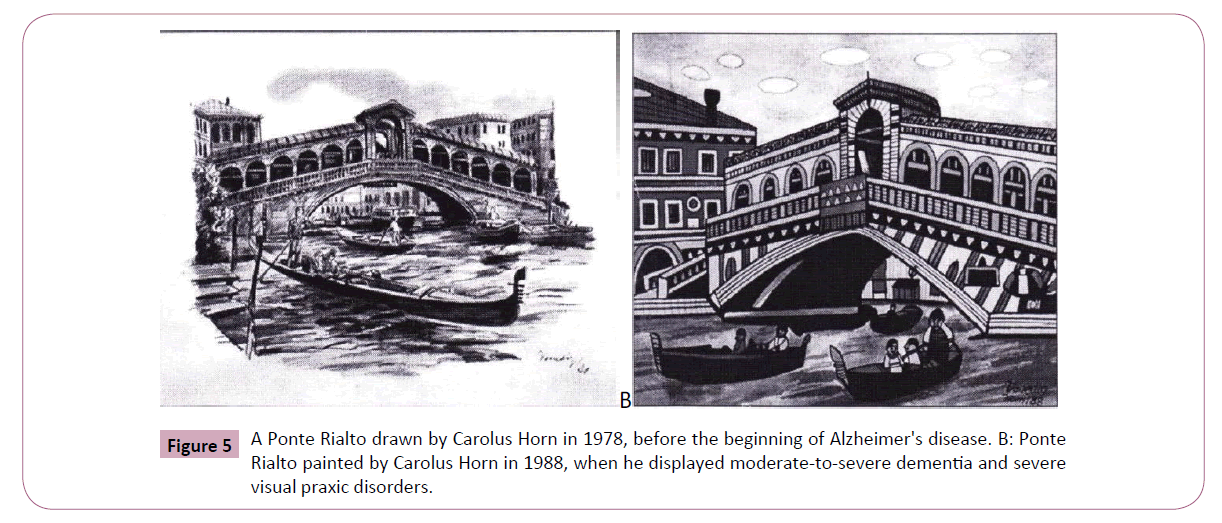
Figure 5: A Ponte Rialto drawn by Carolus Horn in 1978, before the beginning of Alzheimer's disease. B: Ponte Rialto painted by Carolus Horn in 1988, when he displayed moderate-to-severe dementia and severe visual praxic disorders.
2)William Hutermohlen American artist leader in British Pop Art started showing at 61 years his first signs of Alzheimer‘s disease and decided to paint a series of self-portraits that show how the space becomes more and more vague, the pictorial style more and more abstract. These self-portraits show us with a clear creative result the anxiety, the confusion, the sadness of the mentally ill artist (Figure 6).
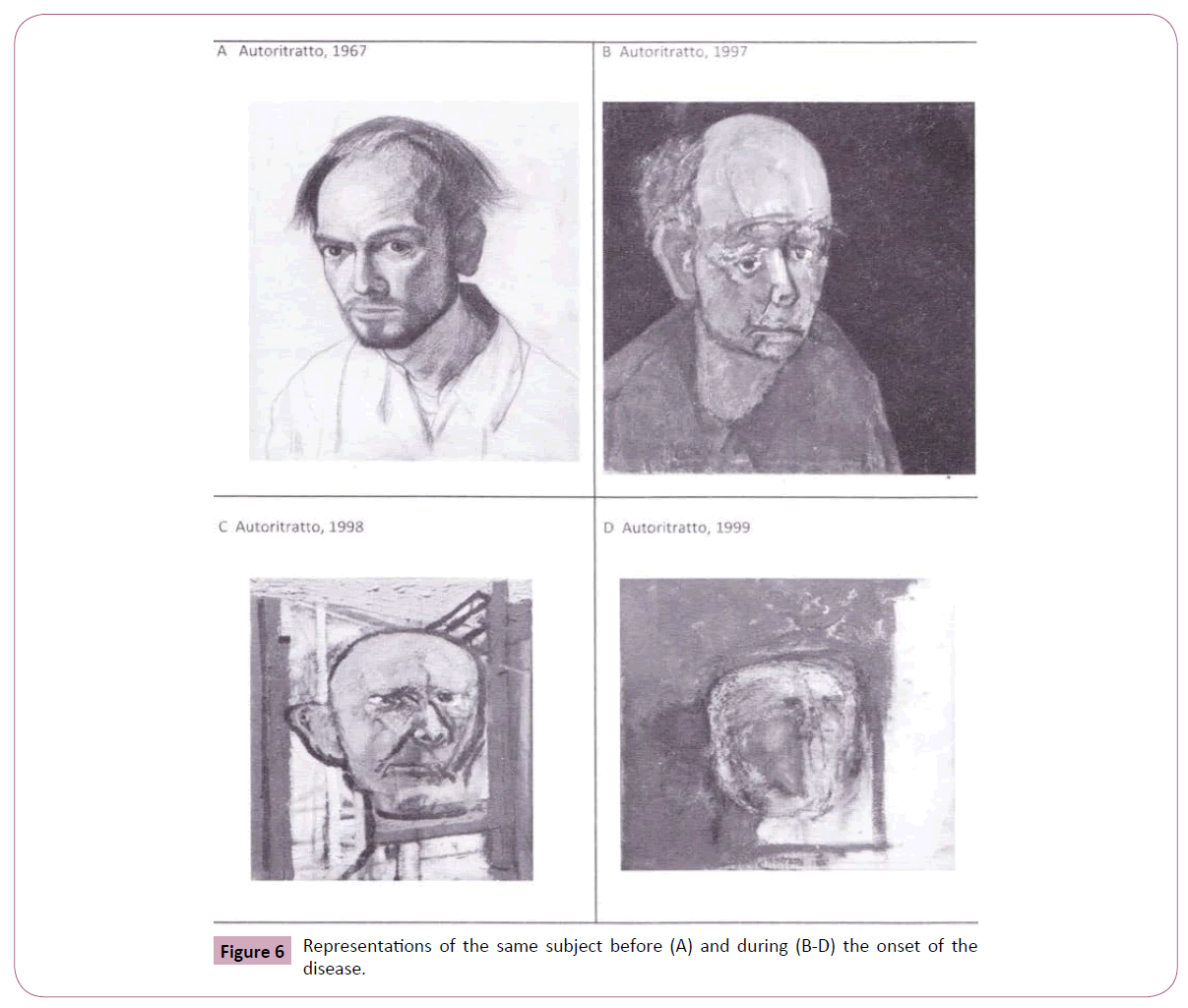
Figure 6: Representations of the same subject before (A) and during (B-D) the onset of the disease.
Conclusion
The aesthetic experience in Alzheimer disease
You can see beauty because it is alive therefore real....The problem is having eyes and not being able to see what happens around you...eyes that are not curious anymore, that are not waiting for anything else anymore...
This was how P.P. Pasolini used to express discomfort.
Do Alzheimer patients still have eyes that can see?
Sight, necessary to decide if something is or not beautiful elicits in the inside world of the patient an arousal of associations, images, intuitions (Figure 7).
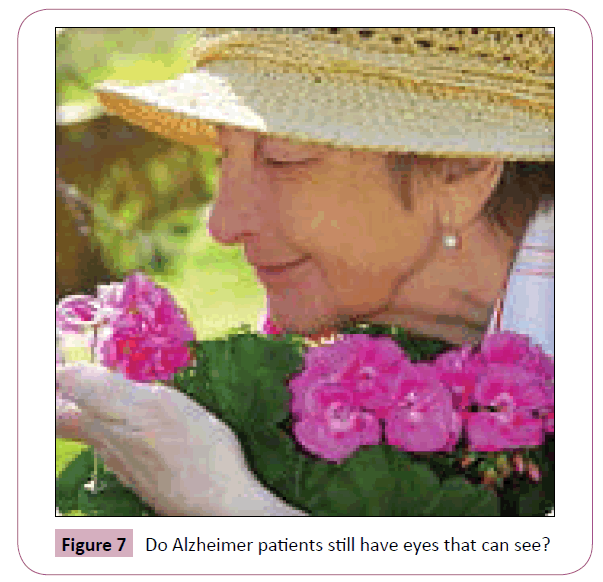
Figure 7: Do Alzheimer patients still have eyes that can see?
Einstein used to say that what is important is not knowledge but imagination.
We said that painting art stimulating emotions enhances the sense of self in the patients. The observation of beauty in art provokes the remembrance of memories that help to take back part of nice enjoyable parts of someone's life.
I would like to end the lecture on dementia and creativity reading the final part of the poem dedicated from a British caregiver to his wife. It is filled with loving acceptance without reserve of his wife's fragility and weakness, emotional and gestural acceptance, more meaningful than the previous appeal and capability of carrying on a conversation that takes to a pacifying memory in a creative way.
Love during Alzheimer Disease [7-11]
....She was an extremely brilliant woman
Beautiful
I will love her until our last talk,
I will always be,
If it needs to be so,
The stranger, even with no name, that holds you in his arms,
That reminds you of the beautiful dancer,
Let her sleep in my arms,
In my arms she will be able to sleep Vesper Fe Marie Llaneza Ramo.
Acknowledgement
Thanks to Monica Vianelli for her help in translation.